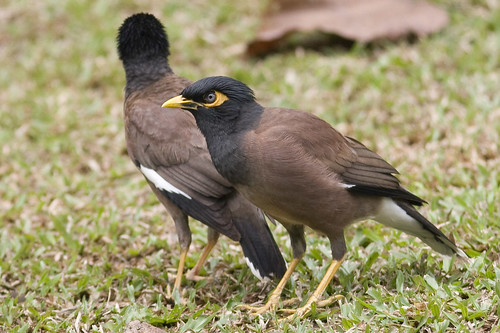
STOMPer Koh saw this bird perched on the dirty plates at Adam Road food centre and shares his concerns here on STOMP.
The STOMPer, who's a doctor, cautions:
"This was taken at Adam Road food centre.
"To be fair to the cleaners at the food centre, the table was cleared right after I took the picture. I'm not sure if they saw me taking the picture.
"I eat here frequently, and it's the first time I've seen this. Usually they clear the tables quite fast.
"Luckily, we don't have the Avian flu but there are other diseases transmissible through our feathery friends.
"Hence, I would like to spread awareness about this possibility, so do be careful."

Update: Chickens running free in Changi: Will they spread bird flu? (6th March 2009)
Bird droppings everywhere because of too many pigeons (29th January 2009)
Crazy pigeon is not afraid of people and steals food from their plates (23rd January 2009)
Uncle feeds pigeons despite 'No Feeding' sign at Bencoolen Street (22nd January 2009)
Neighbour always leaves food for birds! (21st January 2009)
Dead birds found near Taman Jurong market (4th January 2009)
The Javan mynah (Acridotheres javanicus) is Singapore's most common bird, and has adapted extremely well to our urban environment. Being opportunistic and omnivorous, it readily takes advantage of any source of food, from fruit and insects to human refuse and carrion.

Javan mynah, Singapore
(Photo by Lip Kee)
This species is native to Java and Bali, and was introduced to Singapore in the 1920s. However, until at least the 1970s, the common mynah (Acridotheres tristis), was the most common and widespread mynah found in Singapore. However, the Javan mynah has experienced a dramatic increase in population, whereas the common mynah is now much less common than its relative. According to Winged Invaders: Pest Birds of the Asia Pacific by Navjot S. Sodhi and Ilsa Sharp, the Javan mynah population reached almost 300,000 birds in 1985, while the figure now hovers around 139,000, possibly due to competition and predation by the house crow (Corvus splendens), another introduced species. The Javan mynah has also since spread north to Peninsular Malaysia, where besides the common mynah, several other mynah species are known to be present.

Common mynah, Singapore
(Photo by okirakubirder)
It is interesting to see how urban ecosystems can change over time. Due to human introductions or natural range extensions, species establish themselves in new areas, and ultimately affect the local ecology. A checklist of the common birds of urban Singapore in the 1950s would be quite different from a similar checklists of modern day urban Singapore. Since then, the house crow has almost completely displaced the large-billed crow (Corvus macrorhynchos), and the rock pigeon (Columba livia) has become much more common. The tree sparrow (Passer montanus) remains the ubiquitous sparrow of urban Singapore, while the house sparrow (Passer domesticus) has now established itself in Singapore, although it remains very limited in distribution, being restricted to Pasir Panjang and Jurong Island. The formerly common Java sparrow (Padda oryzivora) has become extremely rare; on the other hand, the Asian koel (Eudynamys scolopaceus) has experienced a population explosion. It will be interesting to see how Singapore's urban ecosystem continues to change over the years, as more bird species become established while others die out.
The Javan mynah has been confused in the past with several other similar species. It used to be considered conspecific with the white-vented mynah (Acridotheres grandis), which is native to much of mainland Asia from India to Indochina, with an introduced population in the Kuala Lumpur area. The crest is one way to tell this bird apart from the Javan mynah.

White-vented mynah, Thailand
(Photo by mmp86)
The Javan mynah was also once considered conspecific with the jungle mynah, a bird of India and Indochina, with its range extending south to the northern states of Peninsular Malaysia. The jungle mynah has more orange beak and legs, while the base of its beak is bluish.

Jungle mynah, India
(Photo by Lip Kee)
One final species which might be confused with the Javan mynah is the crested mynah (Acridotheres cristatellus), which is native to southern China, Hong Kong, Taiwan and Indochina. This species was introduced to Penang and Singapore, and was recorded to be breeding sporadically in Singapore during the 1980s and 1990s. However, it has not been spotted locally since 1995, and is either extinct or nearly so. Competition from the Javan mynah and common mynah might be a contributing factor to its decline and disappearance, although the Penang population is apparently still doing quite well, despite the presence of the common mynah. Interestingly enough, in Hong Kong, it is believed that populations of the introduced common mynah are being held in check by the native crested mynah. The crested mynah is readily told apart form the Javan mynah by its darker plumage, distinctive crest, ivory-coloured beak and orange eyes.

Crested mynah, China
(Photo by cleanylee)
The common mynah itself is a relative newcomer to Singapore; in fact, it arrived in Singapore after the Javan mynah. It rapidly spread from India to Indochina in the 1920s, continuing south to Peninsular Malaysia by the 1930s, and was breeding in Singapore by the 1940s. Its favoured habitat consists of forest edges, open country near human settlements, and agricultural land. The clearing of forests and increase in agricultural land definitely helped to accelerate the spread of this species. However, its recent decline in Singapore is probably due to competition with its close relative, as well as the loss of rural land; the population was estimated in 2000 to be around 27,000 birds.
As for the health risk posed to humans by these urban birds, the only disease associated with mynahs is histoplasmosis, a disease of the lungs caused by the fungus Histoplasma capsulatum. The fungus grows in soil and other substrates contaminated with bird or bat droppings. The spores of the fungus then become airborne when the contaminated soil is disturbed. Humans are then infected when the spores are inadvertently inhaled. A large proportion of the population may be exposed to the fungus, but only a small portion, such as infants, young children, the elderly, and other individuals with weakened immune systems are at risk of developing symptoms associated with the disease. There is some risk, yes, but it is quite exaggerated. As for avian influenza, well, I think it would be wise to heed the warning when the mynahs, crows, pigeons and sparrows all start dropping dead.
In any case, it is clear that the presence of mynahs and other birds in and around our food centres is a direct result of the availability of food. If greater steps are taken to ensure that leftovers and refuse are promptly disposed of, limiting the amount of food available to the birds, it is likely that such a problem would lessen.